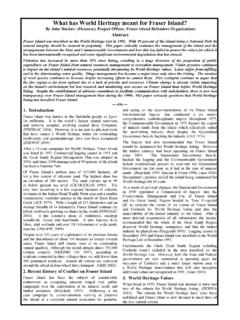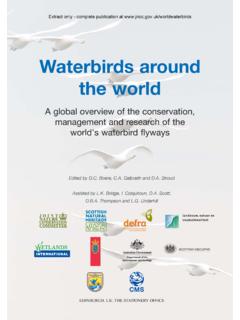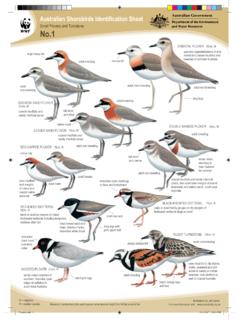Transcription of Great Sandy Strait — A Wetland of International …
1 Great Sandy Strait A Wetland of International Significance Great Sandy Strait (which includes Tin Can Bay) is a Wetland of International Significance. It was inscribed as Ramsar site 992 in 1999. Its 93,160 ha includes marine, estuarine and intertidal wetlands and salt pans. The intertidal Wetland habitats consist of: 15,500 ha of mangrove forests, 12,300 ha of intertidal and subtidal seagrass beds, 2,800 ha of saltmarshes, unvegetated mud, sand and salt flats, and estuarine and channel waters of varying depth and width.
2 The main freshwater Wetland types are Melaleuca swamp forest and other palustrine wetlands. It is a very special place deserving the highest level of protection. The Draft Great Sandy Marine Park Zoning offered it little extra protection. Located between the mainland and Fraser Island, Great Sandy Strait is a complex landscape with shifting patterns of mangroves, sandbanks, intertidal sand, mud islands, salt marshes, extensive sea grass beds and patterned fens. It is important habitat for breeding fish, crustaceans, dugongs, dolphins, marine turtles and migratory waders.
3 It lies between the rapidly growing population centres of Hervey Bay and Tin Can Bay. Great Sandy Strait is a double-ended sand passage estuary. It has large horizontal tide movements because of the relatively flat nearshore. Low water is one kilometre offshore in some areas. The Strait is the largest area of tidal swamps within the South East Queensland bioregion. It is one of the few passage landscapes in Australia where an offshore barrier island has formed sufficiently close to the mainland to block the flow of a substantial river system.
4 It creates a "double" estuary with a shifting pattern of mangroves, sand banks and mud islands. The soils are mostly fluvial sediments. Patterned fens have been recorded along Great Sandy Strait and Cooloola. This type of Wetland is unique in the world. On the eastern side, freshwater swamps merge in many places with the mangroves. Large communities of mangrove invertebrates and fish are present throughout the Wetland . Waders: A wide range of migratory and resident waders, waterbirds and seabirds uses the area.
5 Eighteen of the 24 migratory shorebird species listed under JAMBA and CAMBA use these wetlands. The area is recognized as among the most important roosting sites for migratory trans-equatorial shorebirds in Australia. Counts of up to 40,000 shorebirds have been recorded. It provides one of the most important roosting areas for migratory, trans-equatorial shorebirds in Australia. Waders use the expansive tidal flats intensively, especially near the seagrass beds.
6 The area is also of importance for yearling birds, especially eastern curlews, which do not return to the northern hemisphere until the following year. The rare little tern has been recorded in the area and the endangered beach stone curlews are residents. Mangroves: The mangrove communities represent a transition between temperate and tropical regions. Ten species of mangrove have been identified. Aegialitis annulata and Xylocarpus granatum reach their southernmost limit here. Turtles: All six species of marine turtles found in Queensland inhabit the Strait .
7 They are the green, hawksbill, flatback, Pacific Ridley, loggerhead and leatherback turtles. The Great Sandy Strait is an important feeding ground for juvenile turtles. Rare Butterflies: Old stands of grey mangrove support populations of the endangered Illidge's ant-blue butterfly. Marine Mammals: Great Sandy Strait contains some recognized hot spots for the endangered dugong with high densities of these marine mammals dependent on the sea grass there. Three species of dolphins, the common dolphin, bottlenosed dolphin and the Indo-Pacific, hump-back dolphin, are resident in the area.
8 Fish and crabs: The area is extremely important for the protection of, and as a source of food for, juvenile and adult fish and crustaceans. Seagrass: The seagrass beds contain six species. These areas act as nursery and feeding grounds for prawns and fish, and the feeding grounds for dugong and turtles. Reefs: Coral reefs and "bommies" occur in shallow waters at the northern end of the Strait , at Big Woody Island, Little Woody Island and near Round Island. Spectacular sponges are found on coarse coral grit south of Little Woody Island.
9 A huge artificial reef has also been created north of Big Woody Island. Protection: The Hervey Bay-Tin Can Bay Dugong Protection Area covers most of the Strait . Protected areas within or adjacent to the Strait include Great Sandy National Park (Fraser Island and Cooloola), Poona National Park and Great Sandy Conservation Park. Great Sandy is on the Register of the National Estate. The eastern side of the Strait within 500 metres of Fraser, Dream and Stewart Islands is also part of the Fraser Island World Heritage Area.
10 Fisheries Habitat Reserves cover a large part of the Strait . There remains a question though as to whether this is enough protection. Threats include: Beam trawling continues to disturb the habitat; Increasing urbanization of the western shores; Increasing recreational fishing effort; Increasing recreational power boating resulting in lethal boat strikes of turtles and dugong; The recent establishment of pearl farms; Pressure to increase the amount of aquaculture; The continuing impact from the pine plantation on the mainland changing the pH and hydrology.







